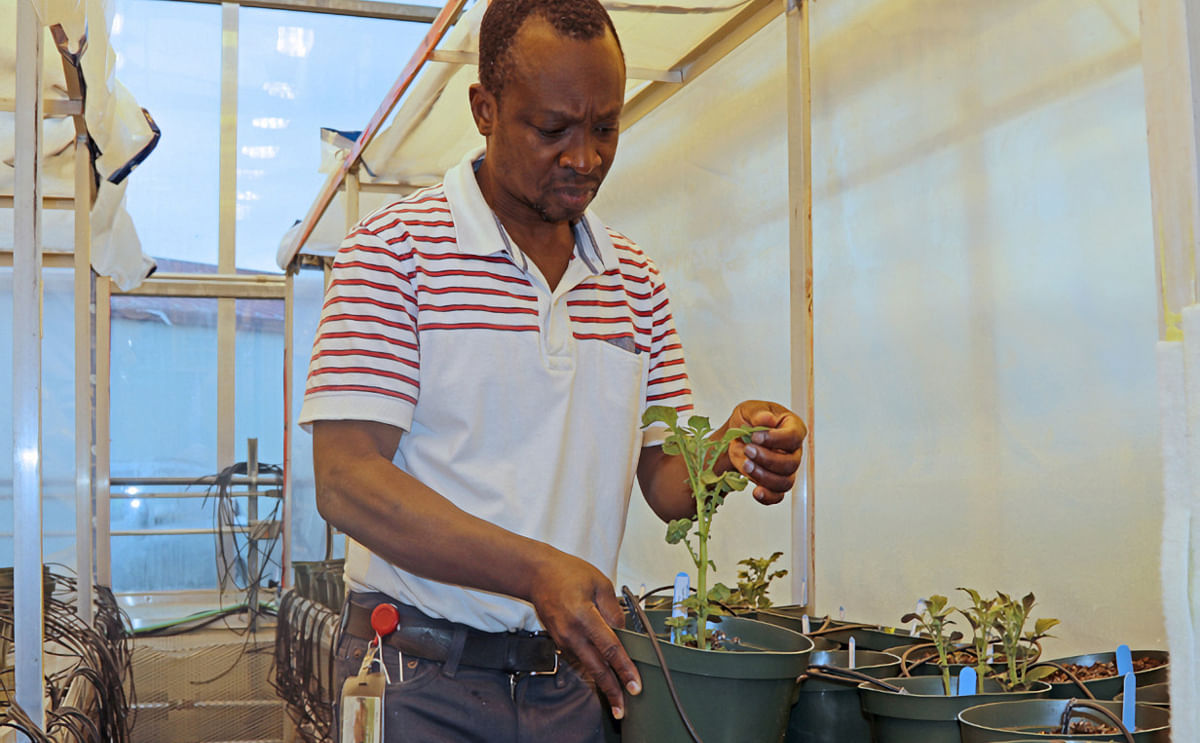Dr. Bourlaye Fofana oversees plant growth in the Harrington Research Farm greenhouse on PEI.
Primaire tabs
Selenium: a booster shot for late blight prevention in potatoes

Europe's potato famine in the 1840s was devastating to potato farmers and caused widespread hunger across the continent. The culprit was late blight disease — a fast spreading disease that causes mold symptoms on potato and tomato crops. Left untreated, the disease can cause widespread damage.
Once late blight is found in a farmer's field, that area must be destroyed along with its crops to prevent the threat of the disease spreading. If the disease cannot be contained, farmers may be required to destroy an entire field as a last resort. This leaves farmers with lost profits as the crop cannot be sold to consumers.
Agriculture and Agri-Food Canada (AAFC) scientists have been studying this disease for many years to ensure that Canada doesn't fall victim to the destruction that late blight had in Europe centuries ago. Dr. Bourlaye Fofana is a geneticist with AAFC in Charlottetown, Prince Edward Island (PEI).
Most recently he has identified several genes in potatoes that are resistant to another serious disease, common scab. However, his previous research of improving human nutrition through plant products laid the foundation for an important discovery for preventing late blight in potatoes.
In 2014, Dr. Fofana studied how selenium, a micronutrient or mineral that is found in soil, water and some foods, can be boosted in foods such as potatoes, soybean and flax. Selenium is essential to the diets of humans and animals and plays a key role in their metabolism.
Bourlaye Fofana, Research Scientist, Agriculture and Agri-Food Canada:
 Dr. Fofana recommends applying selenium to crops when there is no rain in the forecast for one to two days to ensure maximum effectiveness against preventing late blight disease. There are additional benefits of farmers applying this solution. In regions such as PEI where selenium levels are low in soil, this will replenish the micronutrient, helping to improve the plant's nutritional value.
Dr. Fofana recommends applying selenium to crops when there is no rain in the forecast for one to two days to ensure maximum effectiveness against preventing late blight disease. There are additional benefits of farmers applying this solution. In regions such as PEI where selenium levels are low in soil, this will replenish the micronutrient, helping to improve the plant's nutritional value.
With another important discovery under his belt, Dr. Fofana isn't ready to close the book on selenium. He and his team identified genes in potatoes that are activated by the selenium treatment, boosting the plant's immunity and preventing late blight. They also hope to determine whether selenium can prevent other potato diseases after planting.
Key discoveries/Benefits
Once late blight is found in a farmer's field, that area must be destroyed along with its crops to prevent the threat of the disease spreading. If the disease cannot be contained, farmers may be required to destroy an entire field as a last resort. This leaves farmers with lost profits as the crop cannot be sold to consumers.
Agriculture and Agri-Food Canada (AAFC) scientists have been studying this disease for many years to ensure that Canada doesn't fall victim to the destruction that late blight had in Europe centuries ago. Dr. Bourlaye Fofana is a geneticist with AAFC in Charlottetown, Prince Edward Island (PEI).
Most recently he has identified several genes in potatoes that are resistant to another serious disease, common scab. However, his previous research of improving human nutrition through plant products laid the foundation for an important discovery for preventing late blight in potatoes.
In 2014, Dr. Fofana studied how selenium, a micronutrient or mineral that is found in soil, water and some foods, can be boosted in foods such as potatoes, soybean and flax. Selenium is essential to the diets of humans and animals and plays a key role in their metabolism.
Bourlaye Fofana, Research Scientist, Agriculture and Agri-Food Canada:
"Selenium is also an antioxidant, similar to blueberries, which helps reduce the risk of many diseases. I knew that it was possible to increase the health benefit of plants with selenium, but as an antioxidant, can it to boost plant immunity against diseases?"

Healthy potato plants treated with the selenium solution in the Harrington Research Farm greenhouse.
With another important discovery under his belt, Dr. Fofana isn't ready to close the book on selenium. He and his team identified genes in potatoes that are activated by the selenium treatment, boosting the plant's immunity and preventing late blight. They also hope to determine whether selenium can prevent other potato diseases after planting.
Key discoveries/Benefits
- Scientists at AAFC developed liquid solutions containing various concentrations of selenium, an antioxidant. The first spray of selenium solution caused the plant to ready itself to defend against disease and the second spray actually prevented late blight from growing in the potatoes.
- They encountered the same results at AAFC's Charlottetown Research and Development Centre laboratory where selenium stalled the growth of late blight in test tubes.
- There are additional benefits of farmers applying this solution. In regions such as PEI where selenium levels are low in soil, this will replenish the micronutrient, helping improve the plant's nutritional value.
Like to receive news like this by email? Join and Subscribe!
Get the latest potato industry news straight to your WhatsApp. Join the PotatoPro WhatsApp Community!
Uitgelichte Bedrijven
Sponsored Content
Sponsored Content
Sponsored Content
Sponsored Content






